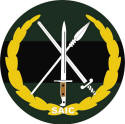South African Infantry Corps
| South African Army Infantry Formation | |
|---|---|

Infantry Formation badge
|
|
| Country |
|
| Branch |

|
| Type | Infantry |
| Motto(s) | Gladium Practamus (Wielders of the Sword) |
| Colors | Green and black |
| Commanders | |
| Current commander |
Major General Rudzani Maphwanya |
| Insignia | |
| Collar Badge | Springbok head |
| Beret Colour | Green (motorised, mechanised, airborne, seaborne and light infantry) Maroon (parachute infantry) |
| Company level Insignia |  |
| SA Mechanised Infantry beret bar circa 1992 |  |
| SA Motorised Infantry beret bar circa 1992 |  |
| SA Infantry beret bar circa 1980 |  |
The South African Army Infantry Formation supervises all infantry within the South African Army.
South African Infantry originated as the Infantry Branch of the Union Defence Forces in 1913.
In 1915, the defence forces established the South African Overseas Expeditionary Force for war service outside Southern Africa. It included the South African Infantry, comprising twelve battalions, and the Cape Corps, comprising two battalions of Coloured volunteers. These units were disbanded in 1919.
The Infantry Branch was enlarged in 1934, and the mounted rifles regiments were converted to infantry in 1935.
In 1943, the Infantry Branch was incorporated into the new South African Armoured Corps, which was divided into armour and infantry branches after World War II.
Based on the findings of a committee led by Brigader H.B. Klopper in late 1953, it was recommended that some English-speaking units be converted to Afrikaans medium units, while other regiments should be amalgamated or contracted.
Despite representations made by some of the units affected, the reorganization went ahead from January 1954. In 1956 a further reorganization was made necessary by the considerable increase in the number of citizens balloted for training in some areas. The Army was accordingly reorganized to consist of 32 Afrikaan-speaking units (including five infantry regiments, 5 tank units and 4 armoured car units) and 20 English medium units (including ten infantry regiments, 4 tank units and 1 armoured car unit). The changes were implemented with effect from 22 September 1956.
In 1954, the SAAC's Infantry Branch, and the personnel of the South African Instructional Corps, were formed into the South African Infantry Corps.
In 1972, continuous national service was increased to twelve months and by 1974, there were 10 full-time motorised infantry battalions, besides the parachute battalion. The infantry reserve comprised 42 citizen force infantry battalions, a parachute regiment and over 200 commando internal defence units.
Plans were in place to establish volunteer black infantry units along ethnic lines, comparable to the Cape Corps.
The volunteer black infantry unit plans eventually bore fruit with the formation of 21, 111, 113, 115, 116 (Northern Sotho, Messina), 117, 118, 121 and 151 Battalions. Another battalion, 114 Battalion, was planned but not actually formed.
...
Wikipedia
